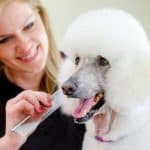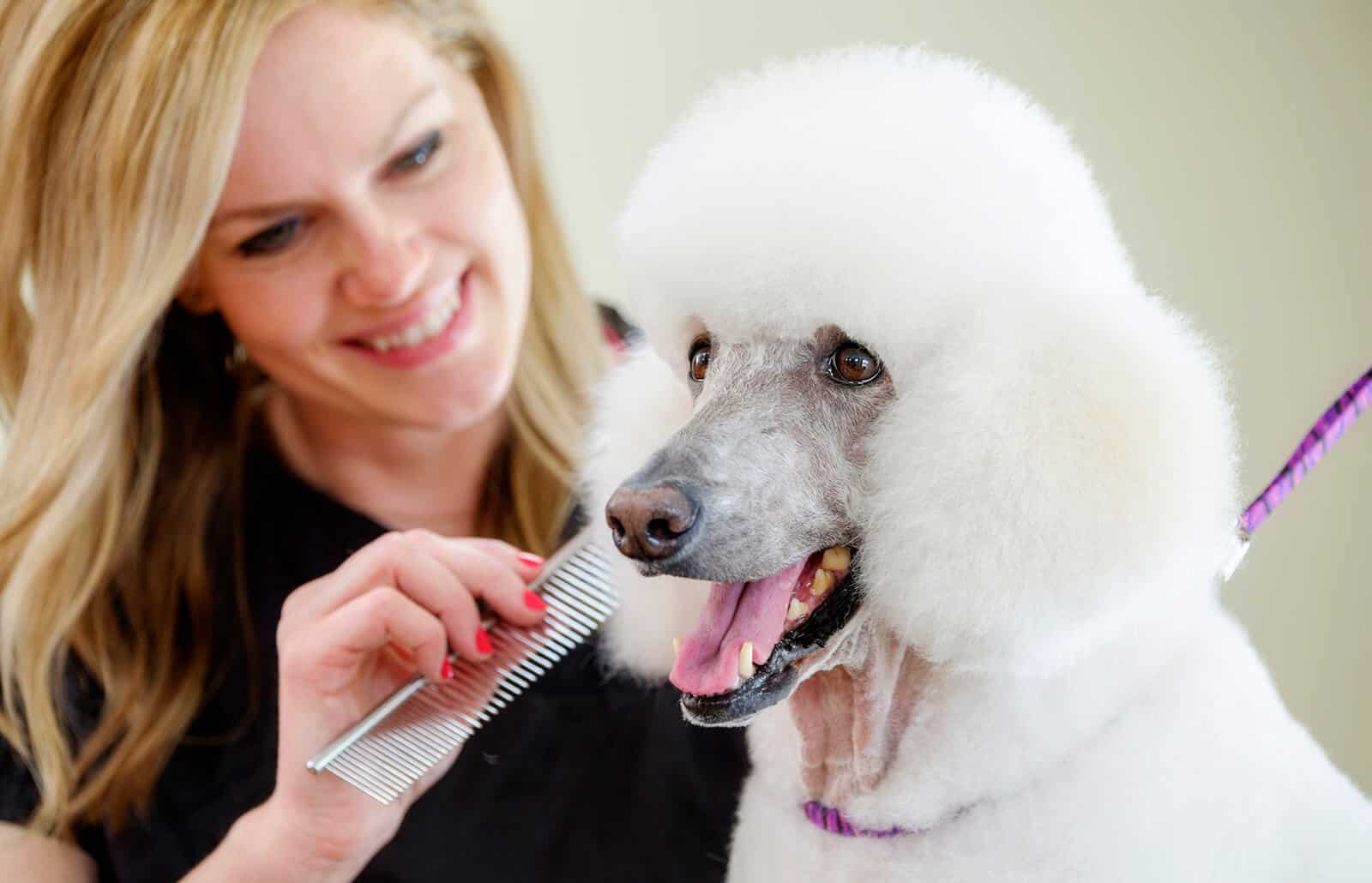Drying the show coat takes time and must be done with no shortcuts. While the Poodle is still standing in the tub, gently squeeze the hair to remove as much water as you can. Wrap the dog in a towel to soak up the additional moisture, take him out of the tub and place him on the grooming table, which should already have been covered with a large, thick bath towel to keep the hair from drying too quickly or tangling.
If the topknot is long, band the hair to keep it from falling into the mouth. Have on hand a pin brush, slicker brush, wide-tooth comb, trigger-spray bottle filled with water (or water with either a little creme rinse or conditioner added) and non-oily coat dressing or finishing spray.
Always dry a show coat with a hair dryer, not only to speed up the drying process but, more importantly, to lift and aerate the hair and make it as straight as possible. The higher the velocity of the dryer, the smoother the hair will be when the dog is dry.
To speed the drying process, many professionals like to use a high-velocity dryer first to blow the water down the hair shaft and off the dog. Once this is done, the drying process is finished with a conventional stand dryer.
If you are drying a Poodle in the Continental or English Saddle trim, start on the short hair first (rosettes or pack, puffs, bracelets) because these sections of the coat tend to dry faster. Brush the hair upward and outward with a slicker to make it as straight as possible.
If you are working for a curly pack on an English Saddle clip, don’t fluff dry this area with a slicker brush. Instead, just lift it with the comb to encourage curls to form, then let it dry naturally. Dry the tail next, using a pin brush.
The long mane hair is dried in layers. While dog show exhibitors and handlers might use slightly different methods to dry the mane coat, their goal is to always brush the hair straight, as it is drying, in the direction you want it to be when the dog is in the show ring.
Probably the most preferred method of drying the long hair is to place the dog on his side on the grooming table with feet facing you. Start in the center of the neck and work backward to the end of the mane. Separate the hair into layers, about 1/2 to 1 inch wide, and as the dryer blows on it, brush it upward and forward.
inch wide, and as the dryer blows on it, brush it upward and forward.
However, when brushing the long mane coat of the Continental or English Saddle clips, be sure to use a pin brush. The brushing strokes should be slow and steady. Start at the ends and work down to the skin. You always want to see the skin at the bottom of each layer.
Use gentle, sweeping brush strokes that go beyond the ends of the hair to keep the tips from splitting or breaking. If you find a matted area, use your fingers to separate the mat into small sections, then use the pin brush to work them out. Once each layer is dry, comb through it with the wide-tooth comb to be sure that no tangles remain.
Keep brushing and drying the hair, section by section, working from the backbone down to the chest. Pay special attention to the hair under the elbows and behind the ears, because mats form very quickly in these areas. To reach the hard-to-get spots under the chest, lift the front leg.
Keep your dryer set on warm, not hot. Keep in mind that during the drying process you are pulling and stretching the wet hair. Hair has a great amount of elasticity, but it can be over-stretched, weakened and damaged by hot air.
Always keep a spray bottle filled with water (or water with a little creme rinse or Hair Care added), a non-oily coat dressing nearby to re-moisturize any areas you are working on that have dried too quickly. Brushing dry hair will cause it to break.
When the first side is completely dry, stand the dog up, remove the wet towel from the top of the table, put down a dry towel, and turn the dog over. Brush and dry the other side of the mane, using the same layering method. If any areas on the second side are almost dry, mist them with the spray bottle to re-wet them, then continue brushing and combing as usual.
Before turning off the dryer, feel the hair and skin to make sure there are no damp areas, especially on or behind the ears, on the neck, the shoulders or chest, or under the elbows. These can become curly, possibly turning into matted clumps overnight, especially when a Poodle’s coat is changing from puppy to adult texture. Wrap or band the topknot and ears when the hair is dry.
Always brush your Poodle the day after the bath because the hair has a pronounced tendency to mat at this time.

